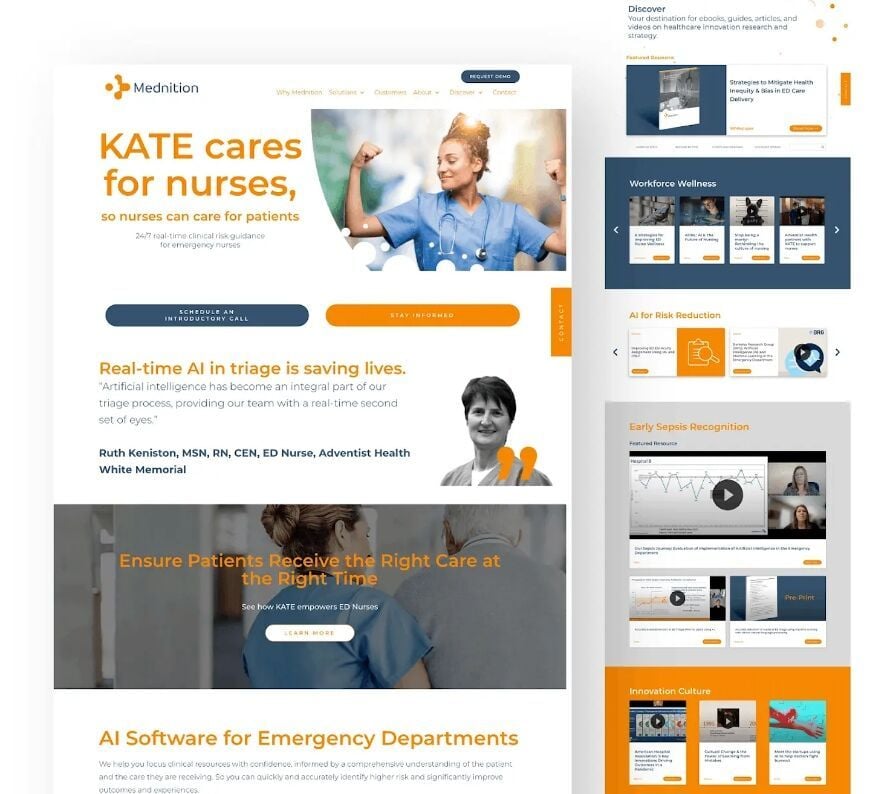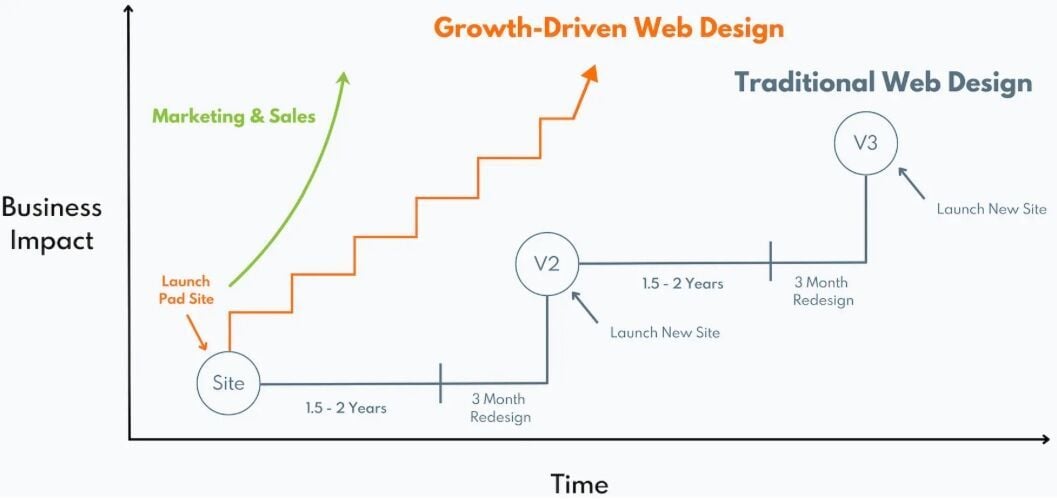Web Design Best Practices: How to Make Data-Driven Decisions to Enhance The User Experience in 2024

- Summary
- Understanding the Landscape: Web Design and Development
- Empowering Growth: The Essence of Growth-Driven Design
- Putting Users First: The Essence of User-Centered Design
- Measuring Success: The Importance of Usability Testing
- Prioritizing Mobile-First Design: Optimizing Experiences for On-the-Go Users
- Enhancing Visibility: The Imperative of SEO-Friendly Design
- Elevating Web Design in 2024 Through Data-Driven Decisions
Did you know that 94% of first impressions relate to your site’s web design? Now, imagine that first impression doesn’t align with the professionalism and strengths of your B2B brand.

In an era where digital experiences reign supreme, the power of effective web design cannot be overstated. Study after study has shown that responsive web design that focuses on performance optimization is critical to acquiring new business as well as retaining clients your brand works with presently.
With evolving user preferences and technological advancements, understanding the significance of data-driven decisions in web design is the key to standing out in the crowd of emerging businesses and brands. But how can companies harness the potential of user data to enhance user experience and achieve their objectives? To answer this, let's delve into the realm of web design best practices, exploring how data-driven approaches can revolutionize the digital landscape in 2024.
Understanding the Landscape: Web Design and Development
To thrive in the competitive digital landscape of 2024, businesses must prioritize agile web design and UX design strategies that align with user expectations and organizational goals. From crafting visually appealing interfaces to optimizing website performance, every aspect of web design plays a pivotal role in shaping user experiences and driving business outcomes. User-centered design all starts with the front page of the site as this is the first impression a business makes on potential clients.
Consider the case of Mednition, a leading provider of AI-based solutions for emergency department nurses, including the innovative platform KATE. By collaborating with O8, Mednition embarked on a journey to revamp its homepage, aiming to enhance the user experience (UX) and effectively communicate the value of KATE to its audience.
Mednition's platform, KATE, leverages natural language processing and machine learning to assist clinicians in triaging patients and diagnosing complex conditions such as sepsis. Engineered to support healthcare professionals in making informed decisions at the point of care, KATE serves as a data-driven safety net, empowering nurses and improving patient outcomes.
O8's approach began with a comprehensive analysis of Mednition's existing homepage, identifying opportunities for improvement and understanding the brand's objectives for the update. With a focus on storytelling, visual appeal, and user journey optimization, the team crafted a new homepage design that seamlessly integrated KATE's narrative while prioritizing ease of navigation and compelling content.
Throughout the design and implementation process, O8 utilized data insights from tools like HotJar to inform decision-making and identify areas for optimization. Heatmaps and user recordings provided valuable feedback on user interactions, allowing for iterative improvements and a refined user experience.
The results of the project were remarkable, with Mednition's new homepage receiving accolades from customers and leadership alike. The revamped design not only enhanced the brand's online presence but also contributed to business growth by attracting new customers and retaining existing ones. The success of the collaboration underscores the transformative impact of strategic web design and development initiatives in driving business outcomes and delivering exceptional user experiences.

As Ryan Kuriakose, Marketing Lead at Mednition, expressed, "You guys have been great to brainstorm with and have been very efficient with deliverables. Thank you all for your hard work to help tighten the messaging! It has gone a long way!"
Given this information, as a business leader, your homepage and its performance optimization should be taken seriously. By working with web development experts in your industry, you can achieve UX perfection that helps funnel clients in the right direction rather than opting for your competitors based on poor site performance alone.
Empowering Growth: The Essence of Growth-Driven Design
Growth-driven design (GDD) has emerged as a dynamic framework prioritizing continuous improvement and iterative optimization, driving sustained growth and innovation in web development projects.
At the heart of GDD lies the principle of user-centricity, where every design decision is informed by user feedback, behavioral data, and performance metrics. By adopting a proactive approach to web development, businesses can rapidly deploy new features, test hypotheses, and optimize experiences based on real-time insights. The result? A dynamic and adaptive web presence that evolves in tandem with user needs and market dynamics.

To begin leveraging the principles of GDD today, start by focusing on incremental improvements rather than wholesale redesigns. Begin with a thorough analysis of your current website's performance and user feedback to identify areas for enhancement. Next, prioritize features and elements that have the potential to drive significant impact on user engagement and conversions. Implement these changes iteratively, continuously monitoring performance metrics and soliciting user feedback to guide further refinements.
Additionally, embrace a culture of experimentation and data-driven decision-making within your team, encouraging collaboration and creativity in identifying opportunities for optimization. By adopting these easy yet effective strategies, companies can kickstart their journey toward GDD and unlock the full potential of their digital initiatives.
Putting Users First: The Essence of User-Centered Design
User-centered design (UCD) prioritizes the needs, preferences, and behaviors of users, fostering intuitive and engaging digital experiences that resonate with target audiences. Without a strong focus on the user when developing and designing your site, you won’t be able to create a system that attracts new clients but rather one that deters them from moving forward with your brand.
According to Northern Arizona University, 88% of users are less likely to return after a bad user experience. For companies looking to increase their sales, create a strong brand image, and grow both internally and externally in the new year, these kinds of statistics should not be taken lightly. Instead, to put your users first, start by trying to navigate your own site alongside your team in the office. Find pain points, reflect on how difficult or easy different parts of the site work , and track loading times. As Steve Jobs once said, “Design isn’t just what it looks like and feels like — design is how it works.” This is why, although the visual experience is important as well, UX should always begin with a strong taxonomy and customer journey infrastructure.
As we at O8 state when it comes to website design, “Many creative agencies don't prioritize UX and usability, resulting in a design that looks pretty and makes marketers happy but doesn't actually produce optimal business results. We provide the antithesis.”
To begin to implement user-centered design strategies today, start by conducting user research, including surveys, interviews, and usability testing, to gain valuable insights into the challenges users face and the features they value most.
Uncover hidden opportunities on your website. Schedule your free UX audit today
With this knowledge in hand, prioritize simplicity and intuitiveness in your website's design, ensuring that navigation is seamless and information is easily accessible. Incorporate user feedback throughout the design process, soliciting input at key milestones to validate design decisions and iterate accordingly.
Moreover, embrace a process of continuous improvement, monitoring user interactions and performance metrics post-launch to identify areas for refinement and optimization. By fostering a user-centric mindset and integrating UCD principles into every stage of the design process, companies can create digital experiences that resonate with users and drive long-term success.
Measuring Success: The Importance of Usability Testing
Usability testing provides invaluable insights into user behavior and preferences, enabling businesses to identify pain points, refine designs, and optimize experiences for maximum impact.
Think of these tests as the ultimate determinant for whether or not your site functions in the ways it needs to in order to gain new customers and retain current ones. Usability testing serves as a crucial tool for validating design decisions, uncovering usability issues, and iteratively improving website functionality.
By engaging real users in structured testing scenarios, businesses can gather qualitative and quantitative feedback, identify pain points, and prioritize enhancements based on data-driven insights and accessibility metrics. From A/B testing to heat mapping, usability testing empowers businesses to fine-tune their digital experiences and drive continuous improvement.
As previously stated, applications such as Hotjar are often used by web design and development experts such as our team at O8 to optimize the structure and flow of a brand’s site for the better.
However, there are many other techniques that companies can implement to test usability moving forward. For instance, B2B companies can benefit from implementing any of the following methods for usability testing in 2024:
- Conducting moderated usability testing sessions with real users to gather qualitative feedback on the website's functionality and user experience.
- Implementing remote usability testing tools to reach a broader audience and gather insights from diverse user demographics.
- Utilizing eye-tracking technology to understand user attention and interaction patterns, helping to optimize visual hierarchy and content placement.
- Employing A/B testing methodologies to compare different design variations and determine which performs best in terms of user engagement and conversion rates.
- Leveraging heatmaps and click-tracking tools to visualize user interactions and identify areas of interest or friction on the website.
- Incorporating session recordings to observe user behavior firsthand and gain insights into navigation patterns and pain points.
- Engaging in guerrilla testing by soliciting feedback from users in informal settings, such as coffee shops or public spaces, to gather quick and candid insights into usability issues.
- Collaborating with user experience (UX) experts and conducting heuristic evaluations to assess the website's adherence to usability principles and identify areas for improvement.
With these strategies in place, company leaders can finally focus on the big-picture goals of the brand and let the site speak for itself to acquire new clients and retain them consistently.
Prioritizing Mobile-First Design: Optimizing Experiences for On-the-Go Users
A mobile-first design emphasizes the importance of crafting seamless and engaging experiences tailored to the preferences and behaviors of mobile users, driving conversions and enhancing brand perception.
Did you know that 85% think that a company's mobile site should be as good or better than a desktop site and that mobile users are 5 times more likely to abandon a task if a site isn’t mobile-optimized? As a business marketing leader, the last thing you want is to fall prey to these kinds of unnecessary losses. Instead, by optimizing the mobile version of your site with the same care and consideration as the desktop version, you can ensure that users on both systems are satisfied and your bounce and conversion rates reflect this.
In order to develop a mobile site as data-driven and interactive as your desktop site, you may want to use an agency to outsource your marketing and design efforts. After all, mobile optimization is a bit different from standard SEO site optimization and every small detail matters.
However, you can also start to make a dent on this mobile-first design project by conducting a comprehensive audit of your website's mobile performance, identifying areas where user experience may be compromised on smaller user interfaces.
Embrace a content-first approach, focusing on delivering concise, relevant information and minimizing clutter to enhance readability and engagement on mobile devices. Additionally, prioritize responsive design principles, ensuring that your website adapts seamlessly to various screen sizes and orientations.
By adopting a mobile-first mindset and prioritizing the needs of on-the-go users, companies can create digital experiences that are not only accessible and user-friendly but also aligned with the evolving preferences of today's mobile-centric audience.
Enhancing Visibility: The Imperative of SEO-Friendly Design
SEO-friendly design incorporates best practices for search engine optimization, ensuring that websites are easily discoverable, rank highly in search results, and attract organic traffic, leading to increased visibility and business growth. There are an endless stream of articles on the internet explaining every way to optimize your site with SEO principles in mind. However, which ones are right and which are outdated? this can be difficult for companies to navigate and keep up with. To help as you get started, follow some of the basic SEO-friendly design principles outlined below by the O8 SEO experts:
- Implementing keyword research: Conduct comprehensive keyword research to identify relevant terms and phrases that align with your target audience's search intent. Integrate these keywords strategically into your website's content, meta tags, and headings to improve visibility in search engine results pages (SERPs).
- Optimizing website structure: Streamline your website's architecture to make it easier for search engines to crawl and index your pages.
- Improving page loading speed: Optimize your website's performance by minimizing page load times, optimizing images, and leveraging browser caching. Fast-loading pages not only enhance user experience but also contribute to higher search engine rankings.
- Enhancing mobile responsiveness: Ensure that your website is fully optimized for mobile devices, providing a seamless browsing experience across various screen sizes and resolutions.
- Creating high-quality, relevant content: Develop compelling, informative content that addresses the needs and interests of your target audience. Focus on creating original, valuable content that demonstrates expertise, authority, and relevance in your industry.
- Earning backlinks from authoritative sources: Cultivate relationships with reputable websites and industry influencers to earn high-quality backlinks to your site. Backlinks from authoritative sources signal to search engines that your website is trustworthy and worthy of higher rankings.
- Optimizing meta tags and descriptions: Craft compelling meta titles and descriptions that accurately summarize the content of each page and entice users to click through to your website. Incorporate relevant keywords naturally while maintaining readability and relevance.
- Collaborating with SEO experts: Partner with experienced SEO professionals such as O8 to develop and execute a comprehensive SEO strategy tailored to your business goals. SEO experts can provide valuable insights, guidance, and technical expertise to help your website achieve optimal visibility and performance in search engine results. As Leila De la Fuente of HelpSystems stated, “The team at O8 has been instrumental in helping our company elevate our web user experience.”
While these are just some of the myriad ways you can begin to optimize your site with SEO design in mind, they are a wonderful foundation for the new year and serve as a great step in the right direction both for your company as well as your clients.
Elevating Web Design in 2024 Through Data-Driven Decisions
Whether you're considering a revamp of your homepage, exploring growth-driven design methodologies, prioritizing user-centered design principles, or enhancing your site's visibility through holistic user-friendly strategies, the key takeaway is clear: action is imperative.
Take the next step by partnering with industry experts at O8 to unlock the full potential of your web presence. By leveraging our expertise and adopting a proactive approach to web design and development, you can position your brand for success in the ever-changing digital landscape of 2024 and beyond. Get in touch to turn insights into action and embark on a journey of innovation and growth.





